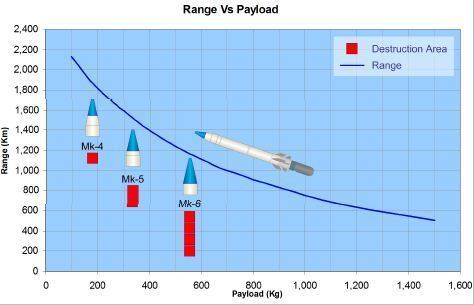Type Cruise missile Hybrid. | Produced 2011 | |
 | ||
Manufacturer | ||
The Shaurya missile is a canister launched hypersonic surface-to-surface tactical missile developed by the Indian Defence Research and Development Organisation (DRDO) for use by the Indian Armed Forces. It has a range of between 750 to 1,900 km (470 to 1,180 mi) and is capable of carrying a payload of one ton conventional or nuclear warhead. It gives the potential to strike in the short-intermediate range against any adversary.
Contents
Description
The Shaurya missile is speculated to be the land version of the under-water Sagarika K-15 missile, although DRDO officials have reportedly denied its connection with the K-15 programme Shaurya is stored in a composite canister, which makes it much easier to store for long periods without maintenance as well as to handle and transport. It also houses the gas generator to eject the missile from the canister before its solid propellant motors take over to hurl it at the intended target.
Shaurya missiles can remain hidden or camouflaged in underground silos from enemy surveillance or satellites till they are fired from the special storage-cum-launch canisters. DRDO scientists admit that given Shaurya's limited range at present, either the silos will have to be constructed closer to India's borders or an extended range version will have to be developed. Defence scientists say the high-speed, two-stage Shaurya is highly manoeuvrable which also makes it less vulnerable to existing anti-missile defence systems. Shaurya can reach a velocity of Mach 7.5 even at low altitudes. On 12 November 2008, the missile reached a velocity of Mach 5 as it crossed a distance of 300 km, with a surface temperature of 700 °Celsius. The missile performed rolls to spread the heat uniformly on its surface. Flight time is between 500 seconds and 700 seconds. It has been described as a complex system with high-performance navigation and guidance systems, efficient propulsion systems, state-of-the-art control technologies and canisterised launch. It can be easily transported by road and launched by TEL. The missile, encased in a canister, is mounted on a single vehicle, which has only a driver’s cabin, and the vehicle itself is the launch platform. This "single vehicle solution" reduces its signature – it cannot be easily detected by satellites – and makes its deployment easy. The gas generator, located at the bottom of the canister, fires for about a second and a half. It produces high pressure gas, which expands and ejects the missile from the tube. The missile has six motors; the first one is the motor in the gas generator. The centrepiece of a host of new technologies incorporated in Shaurya is its ring laser gyroscope and accelerometer. The ring laser gyroscope was tested and integrated by the Research Centre Imarat (RCI) based in Hyderabad.
The Shaurya missile was revealed to be designed specifically to be fired from submarines. A top DRDO scientist has confirmed this and further said that after taking off and reaching a height of about 50 km, the missile starts flying like a Hypersonic cruise missile. Once it reaches the target area it manoeuvres towards the target before striking with an accuracy of 20 to 30 m within the target area.
Testing
The missile was launched from an underground facility with an in-built canister from Complex-3 of the Integrated Test Range at Chandipur.
The missile was successfully test-fired for the third time, from the Integrated Test Range at Chandipur, Odisha, on Saturday 24 September 2011, in its final configuration. The missile flew at 7.5 Mach, and covered its full range of 700 km in 500 seconds. After this test, the missile is ready for production and induction into the Navy.
Production
The first lot of this missile has entered production. Testing was done on 24 September 2011 to validate the production of this missile class by randomly picking a missile from the production lot for testing.
